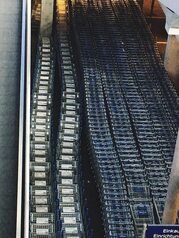The effect of the agricultural environment on property valuation

The agricultural environment has a significant impact on property valuation, especially when comparing rural and urban areas. In Costa Rica, where fertile land and natural landscapes are an essential part of our identity, understanding how these factors affect property appreciation is crucial for investors and owners. As we explore this topic, we will discover why the agricultural environment is not only a vital resource but also a competitive advantage in the real estate market.
The importance of agricultural land in the valuation of real estate.
The quality of agricultural land is a determining factor in the valuation of land, as it directly influences the productivity and sustainability of agricultural activities. In regions where the soil is fertile, owners can achieve higher economic returns through diverse crops, which not only enhances their personal income but also contributes to local economic development. This productive capacity translates into a greater demand for these lands, increasing their market value. Therefore, well-maintained and managed agricultural soil becomes a valuable asset for investors and owners interested in maximizing their profits.
In addition to economic profitability, agricultural land also plays a crucial role in preserving the natural environment. Sustainable farming practices contribute to maintaining biodiversity and improving water and air quality. This creates a positive perception of properties located in agricultural areas, attracting not only buyers interested in investing but also those seeking a healthier lifestyle connected to nature. Thus, the value of agricultural land is not only measured by its immediate productive potential but also by its ability to provide a balanced and sustainable environment, which is increasingly appreciated by today's consumers.
2. Comparison: prices of rural properties vs urban properties
When it comes to evaluating property prices, location plays a fundamental role. In general, urban properties tend to have higher prices due to the constant demand for proximity to services, work, and entertainment. Cities offer advanced infrastructure and access to a variety of amenities that attract both buyers and renters. However, this urban appeal can be countered by the high cost of living and the lack of natural spaces. On the other hand, rural properties are often more affordable, which can be appealing to those looking to escape the hustle of city life or invest in large, fertile land.
Despite generally lower prices in rural areas, it is important to consider how the agricultural environment can influence their valuation. The availability of arable land and proximity to local markets can significantly increase the value of these properties over time. Additionally, there is a growing interest in sustainable and organic lifestyles that make rural areas increasingly desirable. Investors are beginning to recognize that the agricultural environment not only brings natural beauty but also economic opportunities, which could lead to an increase in the appreciation of even rural properties in the coming years.
3. How agricultural production influences land demand
Agricultural production plays a fundamental role in land demand, as land use for agriculture can significantly increase its value. In regions where agriculture is predominant, properties tend to be more valued due to their ability to generate income through crops and other agricultural activities. This not only translates into an increase in added value but also encourages investments in infrastructure and services that benefit the entire local community. The demand for agricultural land, especially those located near markets or urban centers, can drive up prices and attract new buyers willing to pay more for productive land.
Furthermore, the growing interest in sustainable practices and organic production has further modified the dynamics of the agricultural real estate market. Consumers are increasingly interested in purchasing fresh and local products, which increases the demand for land designated for this type of cultivation. On the other hand, government policies that promote sustainable rural development can positively influence the value of these properties by ensuring adequate protection of the natural environment and promoting responsible agricultural practices. Thus, the agricultural environment not only directly affects land prices but also establishes a link between the quality of life of residents and the responsible use of available natural resources.
4. The role of sustainability in rural added value
Sustainability has become a determining factor in the valuation of rural properties, as consumers and investors are increasingly interested in environmentally friendly practices. In a context where sustainable agriculture promotes the responsible use of natural resources, properties located in environments that implement organic farming techniques tend to have a higher value. This is because such practices not only preserve the land and its ecosystems but also produce healthier and more appealing products for conscious consumers. The connection between sustainability and valuation translates into greater demand for agricultural land that operates under these principles.
Additionally, the implementation of sustainable initiatives can transform rural communities by promoting eco-tourism and agritourism. These activities not only provide additional income to owners but also increase the visibility and appeal of rural areas. A property located near sustainable projects or nature reserves is more likely to experience an increase in its value, as the interest in living in harmony with nature grows among those looking to escape the urban hustle. Therefore, investing in rural properties with a sustainable focus not only benefits the immediate owner but also the community as a whole, creating a positive cycle where everyone wins.
5. Agricultural projects that increase the value of neighboring properties
Agricultural projects not only benefit farmers, but they can also increase the value of neighboring properties. For example, the implementation of sustainable crops and organic farming practices not only improves soil quality and the local ecosystem, but also attracts a more environmentally conscious audience. This can result in an increase in demand for nearby land, as many people seek residences close to areas that promote a healthy and sustainable lifestyle. Thus, a community farm or a vineyard can become attractive focal points that elevate interest in surrounding properties.
Moreover, the creation of local agricultural markets or fresh produce fairs can transform a rural area into a desirable destination for those seeking quality of life. These initiatives promote social interaction and community strengthening, which is highly valued by potential buyers. As these collaborative spaces develop, the immediate environment begins to be seen as a prosperous and vibrant place, thereby increasing its appeal and commercial value. In this sense, agricultural projects act as catalysts for sustainable and dynamic appreciation of the real estate market in rural regions.
6. Impact of rural tourism on the valuation of agricultural properties
Rural tourism has emerged as a development driver in many agricultural areas, transforming the perception and value of properties in these regions. The growing demand for authentic and sustainable experiences has led to a significant appreciation of agricultural properties that offer accommodation, interactive farming activities, and connection with nature. This phenomenon not only benefits landowners by increasing the value of their properties but also promotes the conservation of the agricultural environment, leading more people to seek to settle or invest in lands where they can enjoy a quieter and healthier lifestyle. Moreover, rural tourism can encourage investors to diversify their real estate projects by integrating spaces for leisure and recreation within the agricultural context. This strategy not only enhances the visual and functional appeal of the properties but also creates a local economic ecosystem where small businesses can thrive. By fostering a sustainable approach to the appreciation of agricultural properties, a synergy between agricultural production and tourism is established, thus contributing to the social and economic well-being of rural communities while preserving their cultural identity.
7. Socioeconomic factors affecting rural and urban areas
Socioeconomic factors play a fundamental role in property valuation in both rural and urban areas. In the rural context, the local economy often relies heavily on agriculture and related activities. This means that any fluctuation in agricultural product prices or changes in agricultural policies can directly impact property values. For example, if a region experiences an increase in demand for organic products, this could lead to a rise in interest in agricultural land, thereby increasing its value. Furthermore, access to basic services such as education and healthcare also influences this; areas with better infrastructure tend to have greater appeal to potential buyers.
In contrast, urban areas are often affected by different socioeconomic factors that can enhance or diminish property values. Proximity to shopping centers, job opportunities, and efficient public transportation are determining elements for attracting new residents and investors. However, issues such as urban congestion and pollution must also be considered, as they can discourage long-term investments. In this sense, the agricultural environment plays an interesting role; urban areas that integrate green spaces or community gardens not only improve quality of life but can also increase the valuation of adjacent properties by providing a connection to nature and promoting a healthy lifestyle. Thus, understanding these dynamics is essential for those looking to invest wisely in real estate within rural and urban contexts.
8. Future perspectives: Rural or urban? Smart decisions for investors
Investment decisions in properties must carefully consider the differences between rural and urban environments. In rural areas, proximity to agricultural land can offer considerable added value, as these areas are often valued for their biodiversity, tranquility, and connection to nature. Furthermore, the growing interest in sustainable lifestyles has led many to seek properties in rural areas, where one can enjoy a healthier and less polluted environment. For investors, this represents an opportunity to acquire land that not only has potential for appreciation but can also serve as retreats or recreational spaces. On the other hand, urban properties continue to attract those seeking convenience and accessibility. Cities often offer more developed infrastructure, with services such as schools, hospitals, and nearby public transportation. However, unchecked urban growth can create challenges such as congestion and rising living costs. Thus, investors must weigh these factors when deciding where to place their capital. Ultimately, both rural and urban areas present unique opportunities; the key lies in conducting a thorough market analysis and understanding how the agricultural environment influences each of these contexts to make informed decisions that maximize return on investment.



